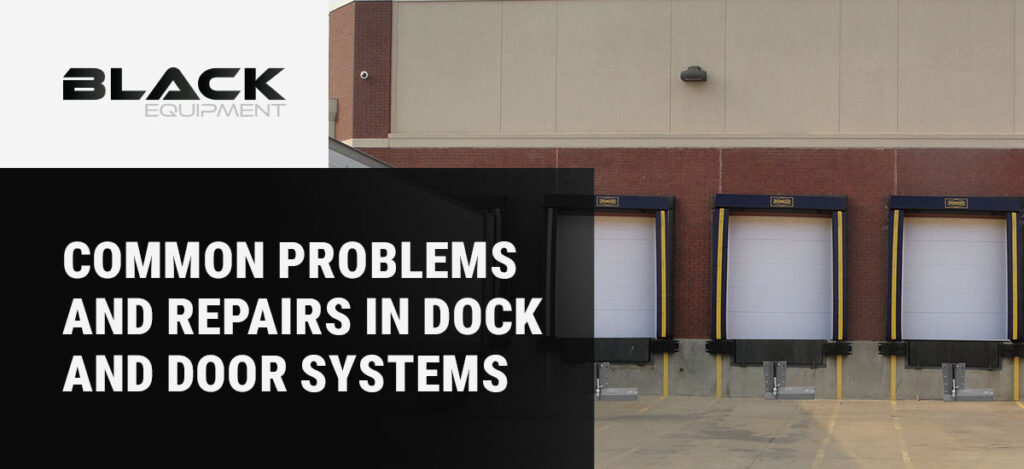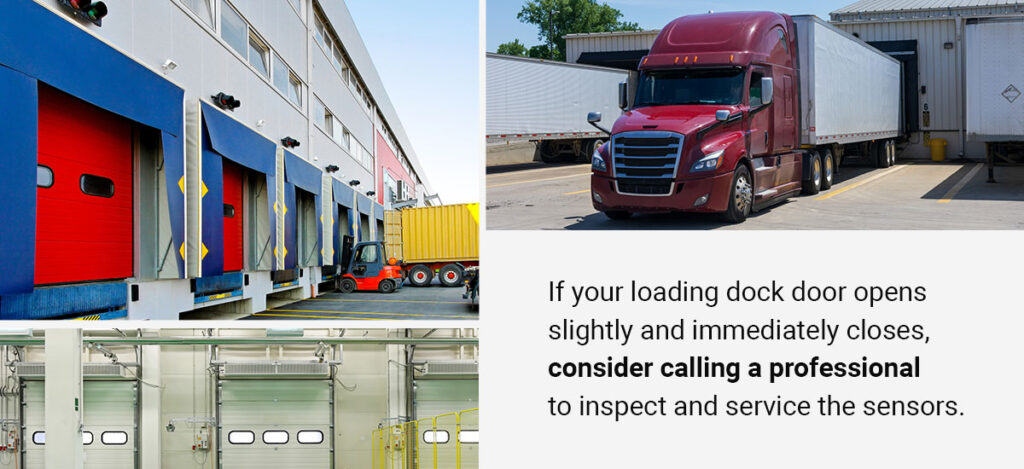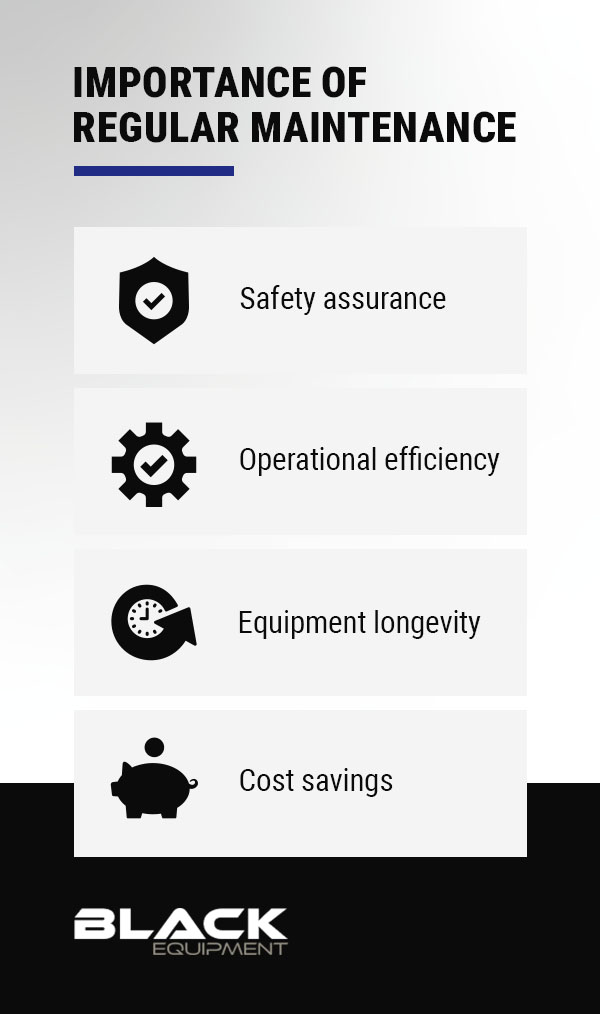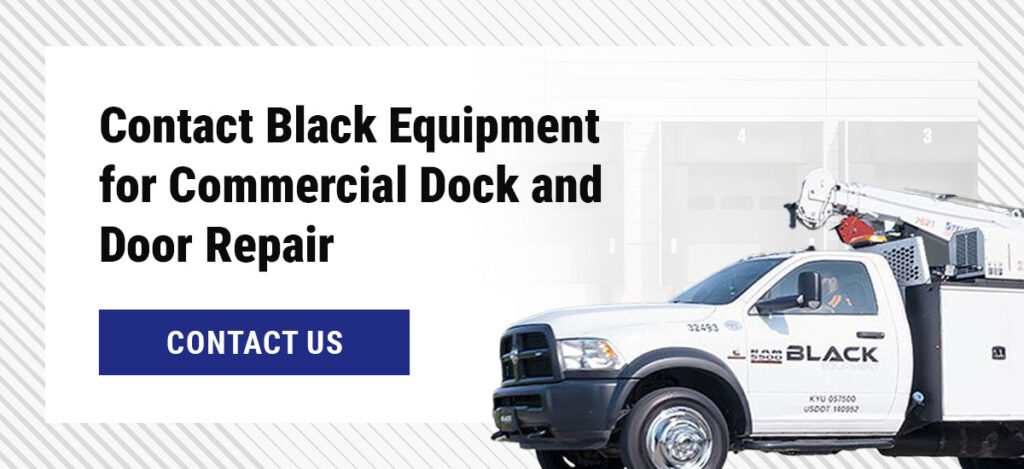Common Problems and Repairs in Dock and Door Systems

Loading dock systems encompass several moving parts, from overhead doors to bumpers and levelers. These elements are subject to damage, either from impact and collision or natural wear and tear. Regardless of the cause, you’ll want an experienced dock and door repair technician on speed dial.
Common dock and door problems include damaged torsion springs, faulty sensors, misaligned tracks and worn-out seals. We’ll explore these issues in detail so you’re well-equipped with the knowledge to spot and prevent them.
11 Common Dock and Door Repairs
Note these standard warehouse dock and door repairs.
1. Damaged Torsion Springs
As critical components of loading dock systems, torsion springs see significant use and pressure each day, making them vulnerable to wear and tear over time.
These spiral-shaped springs store and release rotational energy using torque as a measure of force. They counterbalance the door’s weight, enabling smooth opening and closing. Many torsion springs have ratings of 10,000 cycles, and one cycle equates to the door opening and closing. In other words, the spring should withstand roughly 10,000 turns of the coil.
Your loading dock’s door torsion springs may start degrading after only a few years if you manage heavy, frequent traffic in the loading area. Torsion springs can deteriorate from rust and corrosion with exposure to harsh weather conditions, humidity, salinity and moisture. Improper use and maintenance — such as using the incorrect spring sizes or not lubricating the door — can also lead to premature damage.
These signs indicate it’s likely time to replace your door’s torsion springs:
- Noticeable wear and tear: Visible damage — such as gaps in the coils or frayed cables — is a clear-cut sign of worn torsion springs.
- Opening and closing difficulties: If your door isn’t opening and closing smoothly, it may have damaged torsion springs.
- Strange noises: Worn or damaged torsion springs may be present if you notice grinding, squeaking or popping sounds coming from your door.
Because torsion springs are under extreme pressure, attempting to repair them yourself is risky. Repairing and replacing these components also requires specialized tools, such as adjustable wrenches, winding bars, cordless drills and replacement springs. Call in a professional to inspect and repair your door.
2. Misaligned Tracks
In high-traffic commercial operations, it’s not uncommon for the tracks that guide doors up and down to become dented, warped, twisted or knocked out of alignment after accidental impact. Metal tracks can also come out of alignment due to gradual corrosion. Either way, your loading dock system can’t operate effectively with damaged or misaligned tracks.
Typically, a qualified technician can repair the track and restore its alignment. For more severe damage, however, they’ll likely need to replace the track altogether.
3. Sensor Malfunction
Damaged or unresponsive sensors are another issue. Most loading dock systems are equipped with motion sensors that detect incoming traffic from forklifts, trucks and pedestrians on and around the dock. Over time, these sensors can become misaligned or caked with dirt and grime.

If your loading dock door opens slightly and immediately closes, consider calling a professional to inspect and service the sensors. If you’re experiencing connectivity issues, you’ll likely need to have your wall station and remote-control connections checked and repaired.
4. Damaged Dock Pits and Walls
Many loading dock systems have concrete pits that provide foundations for dock levelers. These pits can naturally degrade with everyday use. Additionally, these systems often have steel side walls, which are susceptible to corrosion.
When these loading dock components lose their structural integrity, they present safety hazards. Regularly inspect the concrete pit, walls and levelers for damage, and consult a repair technician to address any issues.
5. Degraded Loading Dock Levelers
Containing a ramp along its rear edge and a lip hinged at the front of the ramp, a leveler bridges the gap and height difference between the trailer and the loading dock.
Levelers withstand the bumps and impact that come with daily loading. They facilitate the transition of cargo between the docked vehicle and the loading bay, protecting people and inventory from injury and damage.
In addition to the pits and walls that help stabilize dock levelers, the dock levelers themselves can experience wear and damage. They’re often made of steel, which is prone to wear, rust and corrosion — these elements can weaken the leveler’s structural integrity.
Corrosion and rust also make the levelers tougher to operate, resulting in unwanted downtime. Additionally, they pose safety risks for anyone using the loading dock. It’s essential to call an experienced warehouse dock repair provider to replace your levelers when needed.
6. Worn Loading Dock Bumpers
Typically made of heavy-duty steel-faced rubber, loading dock bumpers mitigate significant damage to docks, walls, vehicles and buildings. They serve as the initial point of contact between a building and a truck, receiving the impact created by the driver pulling in against the loading dock.
Naturally, bumpers see substantial wear and tear over time. Inspect your loading dock bumpers regularly to ensure they’re free of considerable wear and safe for use. If bumpers have worn down to their steel angles, replace them immediately.
7. Broken Panels
Door sections are common culprits of loading dock repairs, considering they face extreme wear from continuously moving cargo in and out of trucks.
Every now and then, panels on loading dock doors can take a beating in high-traffic commercial facilities. It’s essential to repair damaged panels as soon as possible to prevent other components — such as tracks, rollers, rails and openers — from becoming damaged.
Repairing individual door sections is relatively quick and simple. However, if you have two or more damaged panels, the door’s safety and structural integrity may be compromised. As a result, a professional will likely need to replace the entire door.
8. Electrical Issues
Many loading dock levelers require electricity to operate, exposing them to issues like control panel malfunctions, faulty wiring and blown fuses. Electrical-related leveler problems can impact your loading dock operations and pose hazards for personnel.
As part of your preventive maintenance schedule, periodically examine your dock leveler’s electrical components, including the control panel, fuses, breakers and wiring. Consult an experienced technician to replace any worn or damaged parts. If your leveler runs on an old, outdated electrical system, consider upgrading to a newer, more reliable one.
9. Door Seal Damage
These foam pads provide a cushion for trailers to press against when backing in, creating a seal around the trailer’s top, left and right sides. While these seals ensure a tight closure, they’re prone to wear in high-traffic loading dock operations.
Seals and shelters help prevent damage from natural elements, such as rain, wind and extreme temperatures. Ironically, they can still deteriorate due to these environmental factors:
- Severe winds
- Heavy rain
- Snow
- Ice and sleet
- Heavy condensation
- Pests like insects, mice and rats
- Debris like dirt, sand, leaves, twigs and pine needles
When inclement weather prohibits your loading dock seals from offering adequate protection, it can lead to unsafe working conditions and productivity loss. The repeated process of trailers compressing and releasing the seal can also lead to punctures, tears, sagging materials or exposed foam.

Like other loading dock equipment, seals require sufficient inspection and maintenance to ensure reliable performance. Promptly replace substantially worn, torn and damaged door seals. A replacement is also wise if you notice gaps with light shining through when a trailer is parked against the seal. Seals should provide a tight, dark seal around the sides and top of the trailer.
10. Hydraulic Fluid Leaks
Loading dock levelers can be mechanical or hydraulic. While mechanical levelers require the operator to physically move the leveler onto the trailer bed, hydraulic levelers use pumps and cylinders to lift, lower and place the leveler automatically. Some models can stop the platform at any point while deploying the leveler and return themselves back to their storage position.
Naturally, hydraulic fluid leaks are prevalent issues in hydraulic loading dock levelers. Hydraulic systems can leak for various reasons, such as worn cylinders, damaged seals and cracked hoses. Leaks can reduce system pressure over time and cause the leveler to break down. On top of creating downtime, this issue poses safety hazards. The fluid can spill onto the loading dock, increasing the risk of slips and falls.
You’ll want to inspect hydraulic components for signs of malfunction or damage. Examine seals, hoses and cylinders, and replace any worn or damaged parts. Look for signs of leaks, like oil buildup around the fittings, and have them repaired as quickly as possible. As a friendly reminder, remember to replenish the fluid with the manufacturer-recommended type and grade.
11. Worn-Out Cables
Cable systems can cause issues in your loading dock system:
- Structural cables: Most overhead doors in loading dock systems include heavy-duty, galvanized cables to support the door’s weight as it opens and closes. These cables are typically very durable and long-lasting, but daily use and harsh environmental conditions can cause them to fray and eventually snap. Shaking, squeaking or operational delays in your loading door may indicate a worn cable.
- Electrical cables: These are vital components in loading dock systems, tasked with distributing communication signals, electrical power and control commands. Damaged or disconnected electrical wiring can disrupt these signals and controls, which can impede normal opening and closing.
Wherever the problem lies, call an experienced technician to rectify the issue. Additionally, regularly monitor cables for signs of cracking or fraying.
The Importance of Regular Maintenance
A consistent preventive maintenance schedule is important to prevent loading dock problems like frayed cables, damaged levelers and electrical issues. The routine upkeep of docks and doors is crucial for warehouses, distribution centers and manufacturing facilities that ship and receive inventory. Ongoing loading dock maintenance promotes:

- Safer working conditions. Routine maintenance reduces the risk of equipment malfunctions that can injure personnel on the job. Properly maintained doors and docks help keep employees and cargo out of harm’s way.
- Cost savings. By taking measures to prevent loading dock malfunctions and breakdowns, you can avoid expensive repairs down the line.
- Efficient operations. Defective loading dock equipment interrupts warehouse workflows and wastes precious time and money. Regular maintenance helps ensure high-performing equipment and enhances overall efficiency. Functional, reliable loading docks and doors facilitate product flow, minimizing delays and downtime.
- Equipment quality and life span. Addressing and preventing issues in loading dock systems preserves the integrity of your equipment. It extends the service life of your docks and doors and helps you avoid costly premature replacements.
Preventive Maintenance Tips for Loading Dock Systems
Here are recommended measures for maintaining your loading dock equipment:
- Train your staff: Proper training equips your staff with the skills and know-how to recognize potential issues in loading dock systems. Your personnel should be well-versed in safe equipment operation to prevent damage and injury. Educate your staff on proper equipment use and how to identify red flags in loading dock systems.
- Keep loading docks clean and gunk-free: While it’s normal for staff to get hungry on the job, ensure your team knows the loading dock area is not the place for eating and drinking. Crumbs and dried liquids on the loading dock surface can create unnecessary messes and attract pests. Aside from being an eyesore, unkempt loading dock surfaces can create hazards for workers. Trash, oils, fluids and other debris left on loading docks can lead to trips and falls. Your loading dock is the focal point for material handling and inventory flow, so it’s important to keep it in clean, immaculate condition.
- Conduct routine inspections: By regularly inspecting your commercial docks and doors, you’re more likely to spot areas of concern. Look for issues like rust and corrosion, loose hardware, worn or kinked cables, and hydraulic fluid leaks.
- Choose an experienced maintenance provider: Working with a knowledgeable repair company is one of the best things you can do. A loading dock and door service provider can handle everything from installations to repairs and preventive maintenance. When you run into issues with your loading dock system, you deserve a dependable partner who can provide prompt services and get your equipment back up to par. Choose your provider wisely, and let reviews and credentials guide your selection process.
Contact Black Equipment for Commercial Dock and Door Repair
Warehouses need reliable, efficient loading dock equipment for smooth material handling operations. Black Equipment provides installation and repair services needed to maintain the performance you expect from your loading dock systems. We’re your go-to source for expert loading dock services, including:
- Consulting: We’ll help you determine and specify the best dock equipment for your needs.
- Installation: Our technicians have extensive knowledge of loading dock equipment, ensuring a high-quality, efficient installation job.
- Repairs: We handle all types of repairs, from minor tune-ups to full door replacements. Whether you need a door track realignment, leveler maintenance, concrete spalling repair or a new door panel, our team is here for you.
- Preventive maintenance and inspections: Our highly trained technicians perform comprehensive maintenance for commercial docks and doors and other loading dock equipment. This includes services for cables, rollers, hinges, locks, springs, mechanical and hydraulic levelers, electric controls and other accessories. We also conduct routine inspections to confirm all dock and door components are safe and functional. Additionally, we provide annual fire door testing to ensure your organization complies with all relevant safety regulations.
If you have other questions, feel free to browse our FAQ page for common inquiries about repairs and maintenance. Turn to us for quality loading dock repairs and replacements. Contact one of our specialists to learn more about our maintenance solutions or schedule a service.
